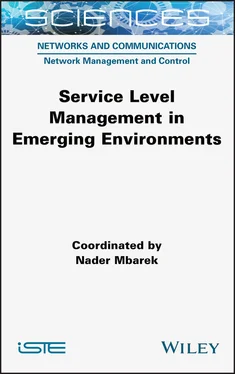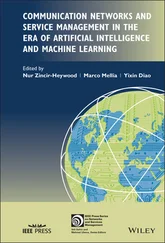In Chapter 2, Nader Mbarek describes the Cloud environment in terms of Cloud Computing, Cloud Networking and inter-Cloud. The author specifies the context and motives around guaranteeing service level in the Cloud in terms of QoS and security. A framework for guaranteeing the QoS in the Cloud Networking environment is introduced.
In Chapter 3, Samira Chouikhi, Leila Merghem-Boulahia and Moez Esseghir explore demand management as a service offered to consumers in a smart grid environment. They describe this environment and its essential components and also explain fundamental concepts of demand management. They focus on demand-side management, more specifically on energy consumption planning.
In Chapter 4, Mohamed-Aymen Chalouf introduces e-health systems, offering an overview of their architecture and characteristics. The author then describes the security and QoS challenges in this kind of environment and discusses several research papers and projects aimed at providing appropriate management solutions.
In Chapter 5, Hajer Bargaoui, Nader Mbarek and Olivier Togni introduce characteristics of wireless mesh networking, highlighting QoS management. The authors define routing concepts based on QoS in wireless mesh networks and describe Hybrid QoS Mesh Routing (HQMR) as an example of a routing protocol based on the defined QoS for this kind of environment.
In Chapter 6, Axel Moinet and Benoît Darties introduce the concept of blockchain through its basic characteristics and operating principle. The authors then describe how blockchain can fit into a model dedicated to the IoT in order to respond to authentication and trust challenges in this kind of environment. Blockchain Authentication and Trust Module (BATM) architecture is introduced as a solution that can respond to these challenges.
In Chapter 7, Chérifa Boucetta, Hassine Moungla and Hossam Afifi describe the emergence of D2D communications, focusing on the discovery of terminals in this kind of environment. It is essential, in this context, to optimize neighbor discovery in order to provide users with a high QoS while also ensuring the economizing of resources. The authors evaluate how an automatic learning strategy may contribute to a D2D environment.
In Chapter 8, Mohammed Salih Bendella and Badr Benmammar introduce not only green networking but also cognitive radio. They then study the impact of cognitive radio on green networking based on learning through reinforcement in order to extend the life of a network and reduce its energy footprint.
We hope that this book will help readers gain a greater understanding of the challenges and important issues related to service level management in emerging environments, as well as in their current works that focus on managing QoS, security and mobility in this kind of environment.
1
Service Level Management in the Internet of Things (IoT)
Ahmad KHALIL, Nader MBAREK and Olivier TOGNI
LIB, University of Bourgogne Franche-Comté, Dijon, France
The Internet of Things (IoT) is now an integral part of our daily life. By 2020, there will be over 20 billion connected digital and electronic devices, which works out to about two devices per human being on Earth (Nordrum 2016). The IoT will thus have a significant impact on human life and will improve quality of life. The future growth of the IoT will lead to advanced use of technology in order to facilitate accomplishing daily human tasks. Consequently, improving corresponding services is an important challenge that must be faced in order to allow the expansion of this environment. In this context, it is expected that there will be a better user experience that will make up for the limitations experienced when using IoT services. User experience may translate to a service level that includes the expected Quality of Service (QoS) and also the expected level of security and privacy offered by the IoT environment. The objects connected to the IoT have certain restrictions in terms of memory, computing capacity and energy consumption. However, existing QoS security and privacy protection mechanisms do not take these constraints into consideration. Thus, it is primordial that we design and develop new QoS and security mechanisms or adapt and improve existing mechanisms in the context of the IoT.
In this chapter, we will first introduce, in section 1.2, definitions related to the IoT environment. We will then describe, in section 1.3, the architectures proposed by different standardization bodies and the fields of application of the IoT. section 1.4introduces security management as well as the management of privacy protection in the IoT through the motivations, challenges and different security services that must be considered in this kind of environment. section 1.5describes QoS management by highlighting the needs and requirements of every layer of the IoT architecture in terms of QoS as well as the proposed QoS mechanisms that will respond to these. section 1.6defines our framework using a three-layer IoT architecture and a QoS-based access mechanism concerning the lowest level of this architecture. Finally, section 1.7presents conclusions and perspectives related to service level management in an IoT environment.
Various standardization bodies have worked on the IoT in order to specify the definitions, architecture, recommendations and the fields of application for this new paradigm. The ITU–T (International Telecommunication Union– Telecommunication Standardization Sector) is a standardization body that works on the IoT environment and its different fields of applications through the SG20 work group. According to the ITU-T document Y.2060, the IoT is a ubiquitous network that is available everywhere, anytime and to anyone (ITU-T 2012). The IoT is a global infrastructure for the information society that makes it possible to offer advanced services by interconnecting objects using various communication technologies (Minerva et al . 2015). Further, in ISO/IEC (2015a), the ISO/IEC (International Organization for Standardization/International Electrotechnical Commission) provides a definition and specification for the vocabulary used within the IoT environment. According to this, the IoT is a network of physical objects that collect and transmit data. It is an infrastructure made up of interconnected objects, humans and information resources that make it possible to process data collected by the objects and then react as a consequence (ISO/IEC 2015a; International Electrotechnical Commission 2017b). According to the Internet Engineering Task Force (IETF), the general idea behind the IoT is to connect objects in order to provide contextual services across different technologies, thereby offering a service available anywhere and at any time (Minerva et al . 2015). The IETF considers the IoT to be a network of interconnected objects that can be addressed uniquely and that use standardized protocols for communication between the objects (Lee et al . 2012). Further, the IETF and ISO/IEC take different requirements into consideration in the IoT environment, such as auto-configuration, unique identification, interfaces standardization, connectivity, reliability and mobility.
We propose a definition that brings together information from all the definitions discussed above: the IoT is a global infrastructure that interconnects objects (which are identified uniquely) and humans to offer advanced, autonomous services via smart interfaces. It must be noted that the unique identification allows the identity of the objects to be verified and enables data processing based on the source of the data.
1.3. IoT: an overview
1.3.1. IoT architectures
Читать дальше












